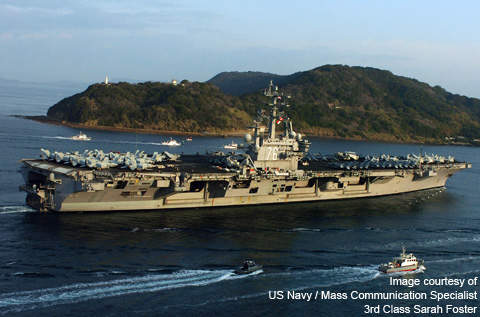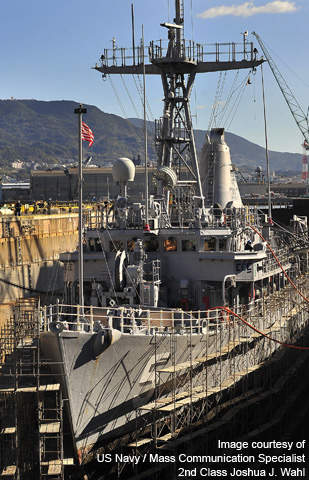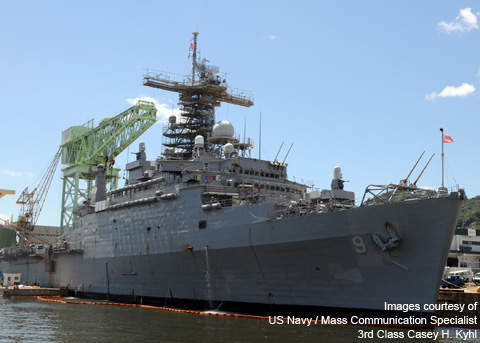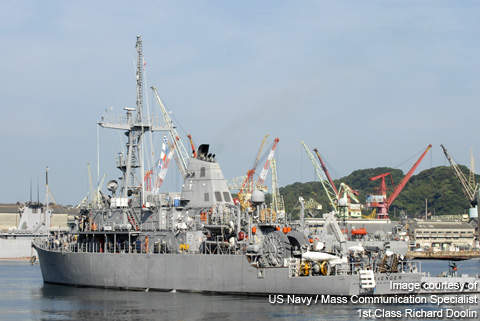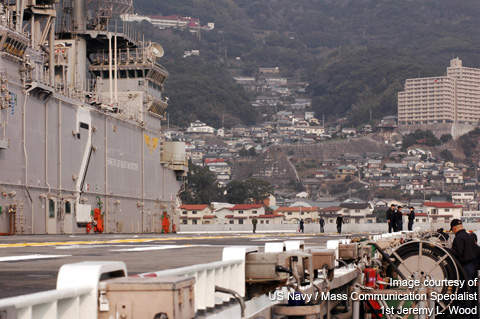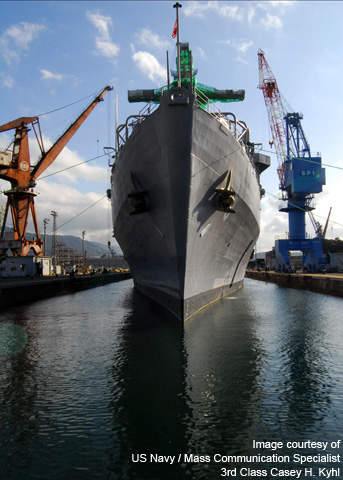The US Fleet Activities Sasebo is a naval base located in Sasebo, southern Japan. The base serves as a focal point for forward-deployed units and other visiting units of the US Pacific Fleet and designated tenant commands.
The US Fleet Activities Sasebo hosts the surface fleet of the Japanese Maritime Self Defence Force and US Navy under a bilateral relationship between Japan and the United States. The base supports the Seventh Fleet of the US Navy to maintain peace and security in the Pacific region.
Location and layout
Situated at the north-western tip of Kyushu, in the Nagasaki Prefecture, Sasebo includes two ship-berthing basins, namely Juliet and India divided by the thin Tategami Peninsula. India Basin is deep enough to berth several large ships, while Juliet Basin is used to accommodate harbour craft.
The large ship yard located west side of the India Basin includes two dry docks and heavy lift cranes. The outer harbour featuring excellent holding strength on a mud and sand bottom, offers a range of anchorages. Typhoon anchorages located near Ebisu Bay are camouflaged by the surrounding hills of Hario Island.
Sasebo history
The Sasebo Naval Station commenced operations in July 1889 as a home base for the Third Naval District of the Japanese Navy. The Combined Fleet vessels sailed from Sasebo to defeat Russia’s Baltic Fleet during the Battle of Tsushima in 1905.
The Sasebo Naval Arsenal employed around 50,000 people at the peak of World War II to build and refit destroyers, light cruisers, submarines and other warships.
The 21st Naval Air Arsenal setup at the Sasebo and Omura locations manufactured 966 aircraft.
The 5th Marine Division landed at Sasebo in September 1945. The US Fleet Activities Sasebo was formally established in June 1946. Sasebo became the main transfer point for the United Nations and US Forces during the Korean war. The base accommodated 20,000 US military personnel at times.
Japan established its Self Defence Forces at Sasebo after the Korean War. Sasebo became homeport for the Japanese Maritime Self Defence Force (JMSDF) ships. The US Fleet Activities Sasebo supported Service Force ships as well as mine craft of the US Seventh Fleet during the years of war in Southeast Asia. The fleet visits at Sasebo were scaled down during the mid-1970s and the base was named as a Naval Ordnance Facility.
US Fleet Activities Sasebo regained its momentum when Seventh Fleet vessels were deployed to Sasebo in July 1980. The base provided logistics support for vessels and marines operating in the Persian Gulf area in 1990-91 throughout Operation Desert Shield / Storm.
Base operations
The Port Operations department manages and controls ship movements at the base. It provides assistance for visiting ships by arranging fuel, food, lodging and transportation. Port Operations owns 24 small craft including LCMs, fire boats, containment boom utility crafts and harbour security boats.
US Fleet Activities Sasebo is home to amphibious assault and transport ships, landing ship docks and mine countermeasures vessels. The major commands based at Sasebo are Afloat Training Group Western Pacific, Det. Sasebo, Assault Craft Units One and Five, Defence Distribution Depot Yokosuka, Det. Sasebo, Navy College Sasebo and Navy Munitions Command East Asia Division, Det. Sasebo.
The ships currently homeported at Sasebo are USS Essex (LHD-2), USS Tortuga (LSD-46), USS Harpers Ferry (LSD-49), USS Denver (LPD-9), USS Avenger (MCM-1), USS Defender (MCM-2), USS Guardian (MCM-5) and USS Patriot (MCM-7).
Garrison facilities
The India Basin, with its 168m wide entrance, can berth several large ships alongside. Other small vessels and harbour craft use Juliet Basin for berthing. The base includes seven fuelling piers, anchorages and mooring buoys.
The major hull and repair works are conducted in a large ship yard located within the base. The Ship Support Complex in the centre of CYFA Sasebo features an instrument calibration laboratory and an oxygen clean room. The base also provides berthing support facilities, fuel facilities and warehouses for the fleet stationed at Sasebo.
Other base facilities
The US Fleet Activities Sasebo offers accommodation at main base as well as in the Hario Housing complex at Hario Village. Other base facilities include a Navy Exchange and Commissary, schools, banks, restaurants, a gymnasium and fitness centre, softball fields, a swimming pool, a sailing centre and a library.

